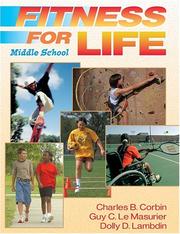| Listing 1 - 10 of 35 | << page >> |
Sort by
|

ISBN: 0736065113 9780736065115 Year: 2007 Publisher: Leeds Human Kinetics
Abstract | Keywords | Export | Availability | Bookmark
 Loading...
Loading...Choose an application
- Reference Manager
- EndNote
- RefWorks (Direct export to RefWorks)
Exercise for youth --- Exercise --- Physical fitness for youth --- Physiological aspects
Book
ISBN: 1803161175 0780819691 9781803161174 9780780819696 Year: 2021 Publisher: Detroit, Michigan : Omnigraphics,
Abstract | Keywords | Export | Availability | Bookmark
 Loading...
Loading...Choose an application
- Reference Manager
- EndNote
- RefWorks (Direct export to RefWorks)
Provides consumer health information for teens about maintaining health through physical activity, including facts about preventing injury and overcoming obstacles to fitness. Includes index and resource information.
Physical fitness for youth. --- Health --- Reference Books --- Health & Fitness --- Reference
Book
ISBN: 9781138891814 9781138891791 9781315709499 9781317486091 9781317486107 Year: 2016 Publisher: Abingdon, Oxon : Routledge, Taylor & Francis Group,
Abstract | Keywords | Export | Availability | Bookmark
 Loading...
Loading...Choose an application
- Reference Manager
- EndNote
- RefWorks (Direct export to RefWorks)
Sports for children. --- Sports for children --- Physical education for children. --- Physical fitness for youth. --- Social aspects.

ISBN: 073604177X Year: 2003 Publisher: Champaign Human Kinetic
Abstract | Keywords | Export | Availability | Bookmark
 Loading...
Loading...Choose an application
- Reference Manager
- EndNote
- RefWorks (Direct export to RefWorks)
Learn how to easily use heart rate monitors_even if you're a novice, incorporate heart rate monitor technology into your high school curricula, facilitate experiential learning that helps students see and feel how heart health fitness fits into the curriculum, add variety to your teaching to keep students interested, and provide athletes with a new way to monitor their progress. The text explains the rationale behind using heart rate monitors and heart zone training in high school curricula. It provides 46 lesson plans that emphasize self-directed learning, goal setting, and self-motivation. It also presents 72 pull-out, reproducible student worksheets and pull-out log and journal pages. (Bron: covertekst)
Aerobic exercises --- Heart rate monitoring --- Physical education and training --- Physical fitness for youth
Book
Year: 2003 Publisher: [Alexandria, Va.] : [Atlanta, Ga.] : USDA, Food and Nutrition Service ; CDC : 100 Black Men of America, Inc.,
Abstract | Keywords | Export | Availability | Bookmark
 Loading...
Loading...Choose an application
- Reference Manager
- EndNote
- RefWorks (Direct export to RefWorks)
Obesity --- Nutrition policy --- Health promotion --- Physical fitness for youth. --- Prevention. --- Planning. --- United States.
Book
Year: 1999 Publisher: Washington, DC : President's Council on Physical Fitness and Sports,
Abstract | Keywords | Export | Availability | Bookmark
 Loading...
Loading...Choose an application
- Reference Manager
- EndNote
- RefWorks (Direct export to RefWorks)
Exercise --- Physical education and training --- Physical fitness for youth --- Health aspects
Book
ISBN: 9780415578035 Year: 2012 Publisher: Abingdon Routledge
Abstract | Keywords | Export | Availability | Bookmark
 Loading...
Loading...Choose an application
- Reference Manager
- EndNote
- RefWorks (Direct export to RefWorks)
""We can reach far more people through sport than we can through political or educational programmes. In that way, sport is more powerful than politics. We have only just started to use its potential to build up this country. We must continue to do so." - Nelson Mandela Nelson Mandela's statement reflects a widely held view that sport can contribute in unique and far-reaching ways to the delivery of important social outcomes. But is this really the case? Can sport bring people from different backgrounds together, and in so doing act as a force for social transformation and change? In the language of policymakers and practitioners, can sport contribute to social inclusion or could it be argued that sport acts to marginalize and disadvantage some groups in society? In other words could sport reinforce, rather than challenge, social inequality? Focusing on youth sport as a touchstone sector of sport in society, this book examines the theoretical and empirical bases of arguments for the role of sport in social inclusion agendas. Authors are drawn from around the world and offer critical perspectives on assumptions underpinning the bold claims made about the power of sport. This book represents the most up-to-date and authoritative source of knowledge on inclusion and exclusion in youth sport. As such, it is essential reading for those who want to use sport to 'make a difference' in young people's lives. It is, therefore, recommended for students, researchers, policy makers and practitioners working in sports development, sports coaching, sport studies or physical education"--
Physical education for children --- Physical fitness for youth --- Sports for children --- Social aspects
Book
Year: 2011 Publisher: [Alexandria, VA] : U.S. Department of Agriculture, Team Nutrition,
Abstract | Keywords | Export | Availability | Bookmark
 Loading...
Loading...Choose an application
- Reference Manager
- EndNote
- RefWorks (Direct export to RefWorks)
Nutrition --- Health --- Physical fitness for youth --- Study and teaching (Middle school) --- Audio-visual aids.
Book
Year: 1995 Publisher: Washington, DC : President's Council on Physical Fitness and Sports,
Abstract | Keywords | Export | Availability | Bookmark
 Loading...
Loading...Choose an application
- Reference Manager
- EndNote
- RefWorks (Direct export to RefWorks)
Exercise --- Physical education and training --- Physical fitness for children --- Physical fitness for youth --- Health aspects
Book
Year: 2012 Publisher: [Washington, D.C.] : U.S. Department of Health and Human Services,
Abstract | Keywords | Export | Availability | Bookmark
 Loading...
Loading...Choose an application
- Reference Manager
- EndNote
- RefWorks (Direct export to RefWorks)
Physical fitness for youth --- Exercise for youth --- Obesity --- Lifestyles --- Health aspects --- Prevention. --- United States.
| Listing 1 - 10 of 35 | << page >> |
Sort by
|

 Search
Search Feedback
Feedback About UniCat
About UniCat  Help
Help News
News